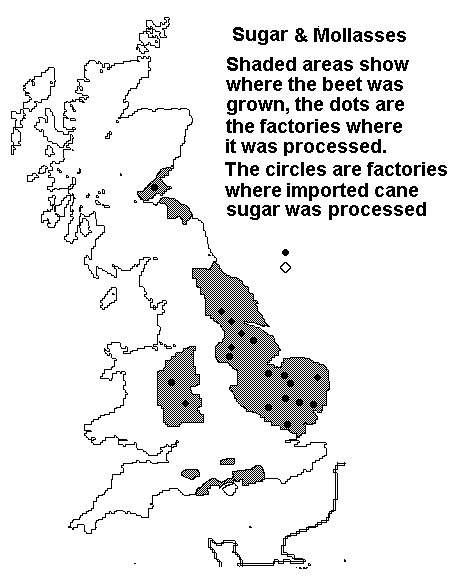Seasonal Traffic
The make up of goods trains varies greatly with the area being considered and the time of year. It would be quite usual to see several trains of coal wagons passing through a station in South Wales, this would be less common in East Anglia where, in season, trains of market garden produce would probably be more common.
Examples of seasonal traffic included seed potatoes being shipped south from Scotland for the traditional planting around Good Friday (late March to early April), Cornish broccoli and Kent's annual crop of hops. The area of West Yorkshire around Leeds and Bradford produced a lot of strawberries and cherries for which seasonal services operated. A combination of wet summers and industrial pollution ended those crops in the 1880's but they were replaced by rhubarb, for which seasonal trains were again run. The various seasons overlapped slightly but generally speaking things flowed quite smoothly. In the South East the Kent fruit crop was followed by the Cambridgeshire fruit and vegetables which was followed in turn by the autumn sugar beet traffic.
I recently came across a photograph of a train load of potatoes on the move, the rake of wagons were all unfitted, so although seasonal this train was not running as an express. Curiously, by accident or design, the rake of wagons was symmetrically arranged; four open wagons, an unfitted cattle van, another four opens and another cattle van and yet another four opens with a cattle van and brake van on the tail. This may possibly have been deliberate, perhaps to assist the shunters when splitting the rake for three different destinations at the marshalling yard. The potatoes were in sacks stacked on end in the open wagons and not piled above the top or sheeted over. To represent such a load you might be able to find small sweets called 'Ticks' which have the right basic shape and size for the big (pre-World War Two) sacks. Adding a little detail such as 'ears' from bits of Milliput to the corners, or a strip of 10x10 thou to represent the ridge where the top of the sack had been roughly sewn shut would help break up the even appearance.
The scale of these seasonal movements was considerable, the Cornish Broccoli crop totalled over thirty thousand tons which translates to about twenty thousand van loads. In the season individual services could get very busy; in the 1890's a Co-Op jam factory in Middleton was receiving perhaps seventy wagons a day, carrying upwards of a hundred and fifty tons of fruit. These special fruit trains arrived at the factory every day for perhaps three months. Other seasonal traffic included grain and imports such as wood pulp and esparto grass (long stemmed grey coloured grasses used in paper making).
Specialised stock for seasonal traffic was not widely used, other stock being pressed into service as required. The East Anglian sugar beet crop was usually moved in mineral wagons, correspondence in the model press mentioned the use of 24.5 ton steel mineral wagons being used in the British Railways era (these wagons are available from Parkside Dundas as a kit). The wagons were not sheeted but I am not sure what colour sugar beet is (I have only managed to find black and white photographs).
Fig___ Sugar Beet Growing Areas & Processing Plants

With the increasing use of milk tank wagons redundant milk vans such as the slat-sided six-wheeled GWR 'siphon's were used for fruit and vegetable traffic and the louvered sided milk vans were used for parcels traffic when not required for milk churns.
Fruit vans were in turn pressed into service for farm produce other than fruit, they were used for parcels trains in the rush before Christmas and even as general merchandise vans on occasion.
Cattle wagons, cleaned out and covered with a tarpaulin for seasonal fruit or vegetable traffic were used by all railway companies and this practice continued under British Railways into the 1960's. As already noted some cattle wagons were properly converted to fruit vans, which proved so successful the LNER and GWR built further examples based on these conversions. Standard British Railways cattle wagons were also converted to fruit vans by BR, these fruit van were in use up to the mid 1970's and represent an easy conversion from a Peco cattle wagon.
Very specialised stock such as the steam heated banana vans would have been confined to specific routes, it would be unusual to say the least to see a single banana van in a general goods train, they were fitted with steam heating to control the ripening of the fruit in transit, a facility not generally available on goods stock. Banana vans, when loaded, would therefore be marshalled at the head of the rake where they could be coupled up to the locomotives steam supply. By the end of the 1960's banana traffic on the railways was in decline and these vans were increasingly used for general goods traffic and marshalled into ordinary goods trains.
There were also seasonal goods, for example blanket makers used to ship entire block train loads in vans to the towns ready for the winter rush. I have seen a photograph of such a rake with a painted tarpaulin advertising the blanket firm tied to the lead van. I am not sure if the railways would allow this to travel through the system as if it broke loose it could flap outside the loading gauge, damaging equipment or possibly injuring passengers on platforms, but it appeared to be well secured.